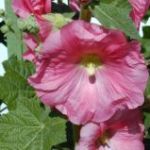| Common Name: |
Hollyhock |
| Botanical Name: |
Alcea rosea |
| Genus: |
Alcea |
| Family: |
Malvaceae |
| Native Location: |
W Asia |
| Cultivation: |
Well-drained soil in sun. Rust may damage the foliage and kill the plant. Leaves may be damaged by plant bugs and caterpillars. |
| Propagation: |
By seed sown in situ in spring or late summer. If required, transplant when seedlings have 2-3 leaves. |
| Harvest: |
Flowers are picked when open and dried for infusions and syrups. |
| Variations: |
Chater's Double
fully double, peony-like flowers ub a variety of colors including pink, maroon, yellow and white
Height: 2-2.5m (6-8ft)
Width: 45-60cm (18-24in)
Nigra
Very dark maroon-black, single flowers
Height: 1.5m (5ft)
Width: 45cm (18in) |
| Height: |
1.2-2.5m (4-8ft) |
| Width: |
38-60cm (15-24in) |
| Hardiness: |
Z3-9 |
| Parts Used: |
Flowers |
| Properties: |
A soothing herb that relieves irritation and soreness, and has diuretic effects. |
| Medicinal Uses: |
Internally for gastritis, coughs, and cystitis. Externally as a gargle for sore throats. Often combined with Inula helenium (See elecampagne), Tussilago farfara (See coltsfoot), and Thymus spp. (See thyme) in cough syrups. |
| Culinary Uses: |
Young leaves are edible. Petals and cooked flower buds can be added to salad. Petals may be used for tea. |
| Bibliography: |
Encyclopedia of Herbs by Deni Brown Copyright © 1995, 2001 Dorling Kindersley Limites. Pp 109-110 |
